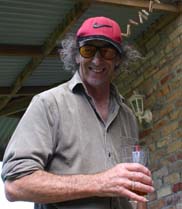
This is a better-late-than-never trip. Some of it has existed in my imagination for forty years - two things in particular have been constants - to visit an aunt and uncle in London and to travel the oceans of the World working on freighters. Well here I am in March of 2005 well into my retirement and about to realise the dream. The passage of time means that I am now to visit cousins and their children in place of departed aunt and uncle and am to travel on a freighter, not chipping rust and repairing hatch covers but as a passenger sharing the officers" facilities.
Two further facets of this adventure have changed with time: the first being greater numbers of dear must-visit friends and family dotted around the globe and secondly a compulsion to walk on the ground in ancestral lands, most notably Northern Ireland and Italy.
Trips (as with New Years) should begin with good resolutions and the more one has, the more of them may be cheerfully broken at a later date. On this occasion I am prepared to reveal one only resolution. The resolution is to travel slowly. Six weeks on a freighter takes care of the first bit. I hope to be away for six months, mainly in the UK.
I won't blather on about preparations except to say that it has been my experience that the time you have to get ready has absolutely no effect upon the number of last-minute things one needs to do and that panic inevitably sets in. So here I am at my daughter Liz's place in serious training.
For most of the last few months I have been living in my camper van at my daughter Liz's rented property on a beautiful Puhoi valley farm 45 minutes north of Auckland. The tranquillity is total except for the occasional party for family, friends and neighbours. It's a hard place to leave.
I should explain that I have been totally indulgent with myself in equipping for the big OE with the best high-tec electronic gear I can afford: laptop computer; Canon 20D 8.2 pixel digital camera and German manufactured sound eliminating head set. My self-evaluated level of competence starts at near one hundred percent on the head phones (ie: I can plug them into the right hole, put them on the right way around, switch on and hear my music or DVD sound tracks) but with the other two items the level of competence drops off to a fraction of a percent by any standard. With the computer I am saved from doom and despair by the good grace of one of my daughters, Noeline, who has set up this web site and is handling the development of the family Cole records and is my help desk. Steep learning curve may be a hackneyed expression but any other would have to contain a multitude of blasphemies to come close. I recommend daughters! I just don't know how to thank them enough. It's like the author's acknowledgements you read in a book: "I dedicate this work to Margaret. I wish to thank daughter Maree for additions to the puriri keepsake, daughter Christine for insisting I have all the health check-ups and for providing the Kathmandu peripherals, daughter Liz for the psychoanalysis and home comforts, son-in-law Mike for storage and transport and all the grandchildren for their unconditional love. Further acts of kindness and consideration and the contributions of other people are too numerous to mention and would indeed fill a book."
As a treat and to celebrate my 67th birthday, I recently took my family, all thirteen of us, on a day-trip to the island sanctuary of Tiri Tiri Matangi, just a short crossing by ferry from Gulf Harbour on the Whangaparaoa Peninsular. We saw a number of endangered birds including the flightless takahe (Notornis) which was thought to be extinct. Amazingly, in 1948 it was rediscovered in a remote South Island valley and has now been successfully acclimatised in a number of predator-free environments. The two photographs here are my illustration of the almost mythical Notornis and the present-day real cheeky takahe.
Contact us at cole@familycole.net Return to Home Page